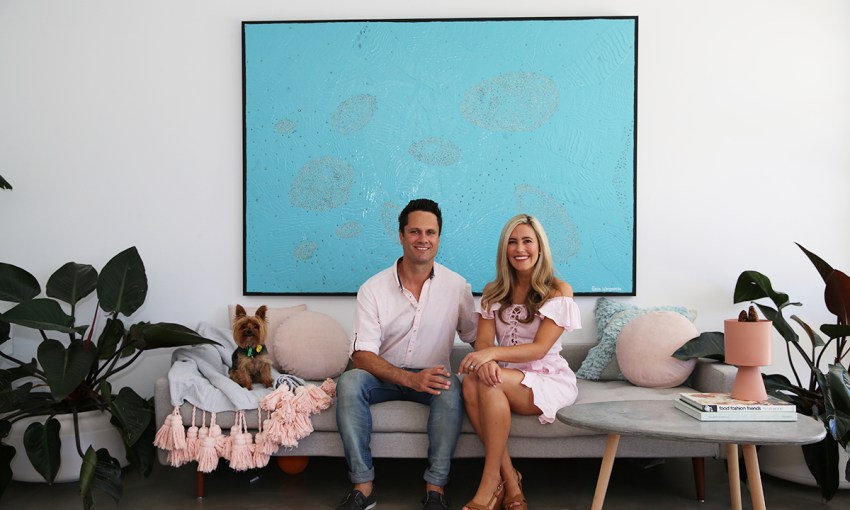One of Australia’s greatest ever footballers grabs his second career chance with as much creative vigour as his first.
Creating a connection
First time I met Gavin Wanganeen, he was on my doorstep. I had asked the Aboriginal Legal Rights Movement for information for an article on indigenous affairs. Well before the internet, the ALRM said they’d send around a work experience kid with a cardboard box of documents.
It was 1990. I’d like to think Gavin said, “Here you are Mr Campbell sir, we hope these can be of assistance”, but neither of us can remember that detail. However, the 17-year-old had just signed with Essendon in the AFL, so I wished him luck in the big time. The response was an early shy Wanganeen smile; no words.
Not that the young Wangas needed much luck. Many of you should know his story by now: brilliant visionary attacking footballer, the Brownlow Medal, AFL flags at two clubs, every honour in the football world, heart-throb of all genders, his name on a grandstand at Adelaide Oval, role model to children in sport, indigenous or otherwise.
Gavin Wanganeen did the lot in Australian football.
Second time I met him, I was on his doorstep. It was this February past, more than 27 years after the first time. Wanganeen has all but left football behind him. He is now an artist, a painter, with his own solo show, Connected, at Hill Smith Gallery from April 12 to May 5.
Director Sam Hill-Smith describes the work as “very subtle and spiritual”, so the temptation is to assume that, given his indigenous background, art came as naturally to Wanganeen as his footy did. In fact, that’s only partly true, and the origins of his second career can be traced to his first one.
Port Adelaide premiership coach Mark “Chocko” Williams liked meetings. It was common to look for light relief after them. In 2006, Wanganeen’s last year as a player, the Power’s “indigenous boys” started a conversation about the art of their culture.
“Daniel Motlop reckoned the Top End had the best Aboriginal art,” Wanganeen recalls. “The Burgoyne boys and I said the Western Desert. So we decided we would each do a painting, then get the rest of the Port players to judge them.”
As I get older I start to understand, all the emotions are coming out. Maybe his mob is speaking to me.
Wanganeen did what any first-timer would do – he went to Bunnings. Without a lesson in his life, he began a dot painting he called Camping at Point Pearce and Wardang Island, because he had been going for family holidays to that part of Yorke Peninsula since he was a child.
Then something must have happened because nothing happened; the first Power indigenous art-off never eventuated, and Camping at Point Pearce, one-tenth finished, was rolled up and shoved in a garage corner. Which was where Pippa Wanganeen found it eight years later, “not taken care of at all”, she says.
“But the minute I rolled it out, the composition, the colours and the story behind it made it precious.” Pippa convinced her husband to complete the painting. Gavin “stuck it on the wall and my love of art began from there”, he says. “If Pippa hadn’t made me finish what I had started, I wouldn’t have this new career.
“Now that I’m a few years into it, I see that I’m painting about my personal cultural journey and I’m absolutely loving it. For 16 years I was busy training and playing football. I guess I missed out on my mum Cheryl’s culture and finding my own identity. Now I learn from aunties, uncles, cousins – there’s always a yarn about our culture when I see them.”
When Wanganeen paints, he keeps nearby photos of his great-grandfather Dick Davey, also known as Jamu Dick, which means “respected”. Dick was a gun shearer at Koonibba Mission, way out to the west of SA. He died at 96 when Gavin was 14. “The way he lived his life as a leader was recognised by both black and white,” his great-grandson says. “His grandchildren the Davey boys have played for Essendon and Melbourne, and Danyle Pearce for Port and Fremantle.
“I’m always glancing at those photos, wondering how tough it was for Aboriginal men and women then. As I get older I start to understand, all the emotions are coming out. Maybe his mob is speaking to me.”
As his wife points out, Wanganeen retired from football a relatively young man, knowing nothing else. From about 1993, his Brownlow year, it became obvious that he could scale any heights, and he did. He doesn’t deny what the sport gave him, and he gives back, such as in his ambassadorial role for Port in the APY Lands.
But art is now Wanganeen’s way of distancing himself from his sporting past. “Football is all about adrenaline, high doses of it, and I can’t do that anymore,” he says. “For me now, finishing a piece is the biggest buzz. There are little bits of adrenaline, but when a painting dries and you put it on the wall, it’s a wonderful sense of achievement.
“The other day I mentored indigenous kids at Ceduna Arts. It was beautiful to be there, and I was approached to go not as Gavin Wanganeen, footballer. I was there as Gavin Wanganeen, artist.”
This article was first published in the April 2018 issue of SALIFE.



